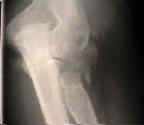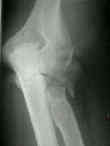- indicated for comminuted radial head frx which occur w/ concomitant MCL injury, dislocation, or RU joint disruption
(Essex Lopresti Fracture);
- will serve as spacer & will prevents proximal migration of radius;
- w/ RU joint disruption, radial head spacer alone does not restore satisfactory axial stability w/o pinning the distal radioulnar joint;
- note that radial neck makes an approximately 15° angle with the radial shaft and some implants contain a slight curve inorder to
take this into account;
- outcomes:
- in the report by Harrington IJ, et al. (2001), the authors performed a long term followup of radial head prosthesis;
- 20 patients were reviewed using a modified Mayo Clinic functional rating index system.
- mean follow-up was 12.1 years, with a range from 6 to 29 years.
- results were excellent in 12 patients, good in 4 patients, fair in 2 patients, and poor in 2 patients;
- metal radial head replacement restored elbow stability when fracture of the radial head occurred in combination with
dislocation of elbow, rupture of the medial collateral ligament, fracture of the proximal ulna, and/or fracture of the
coronoid process;
- authors advocated its use when the radial head cannot be reconstructed in the setting of a clinically unstable elbow;
- ref: The functional outcome with metallic radial head implants in the treatment of unstable elbow fractures: a long-term review.
- in the report by Jaydeep et al, the functional outcomes of arthroplasties with a metal radial head implant for the treatment of
25 displaced, unreconstructible fractures of the radial head in 24 consecutive patients were evaluated at a mean of 39
months minimum, two years);
- there were ten Mason type-III and fifteen Mason-Johnston type-IV injuries.
- 2 of these injuries were isolated, and twenty-three were associated with other elbow fractures and/or ligamentous injuries;
- 3 results were graded as poor; 5 as fair; and 17 as good or excellent.
- asymptomatic bone lucencies surrounded the stem of the implant in 17 of the 25 elbows;
- valgus stability was restored, and proximal radial migration did not occur;
- complications, all of which resolved, included one complex regional pain syndrome, one ulnar neuropathy, one posterior
interosseous nerve palsy, one episode of elbow stiffness, and one wound infection;
- 20 patients were given indomethacin (25 tid) for prophylaxis against heterotopic ossification for 6 weeks;
- references:
- Arthroplasty with a Metal Radial Head for Unreconstructible Fractures of the Radial Head.
- Mid-term outcomes of 77 modular radial head prostheses
- High Risk of Further Surgery After Radial Head Replacement for Unstable Fractures: Longer-term Outcomes at a Minimum Follow-up of 8 Years.
- Vitallium Prosthesis:
- most indicated in cases of elbow dislocation;
- the metal prosthesis provides more stability than silicone prosthesis and does not cause synovitis;
- may restore upto 50% of stability which is lost by excision of radial head;
- elbow must be "booked open" to allow insertion of the metal prosthesis;
- if the elbow has been traumatically dislocated (w/ LCL injury), it can be easily booked open during the case;
- in cases w/o elbow dislocation, consider osteotomizing the lateral epicondyle inorder to free up the lateral restraints, which
allows the elbow to be "booked open;"
- sizing considerations:
- implant size is selected on the basis of the size of the reassembled native radial head;
- the diameter closest to that of the native radial head is employed;
- if optimal size match was not available, the next larger size of implant was used;
- overstuffing:
- be careful not to "over stuff" the component into the joint as this can lead to loss of extension (just as overstuffing
a polyethylene spacer into a total knee replacement can lead to loss of extension);
- ref: Identification of overlengthening after replacement of the radial head with a bipolar prosthesis
- disadvantages:
- aseptic loosening
- implant impingement
- component removal can be especially difficult;
- Allograft Radial Head Replacement:
- main indication may be a comminuted radial head frx with frx extension into the radial neck, since radial head prosthesis are not
design to replace the neck;
- radial head is approach via Kocher Approach;
- annular ligament is dissected off the ulna w/ a piece of bone;
- mirror image step cuts are made in the proximal radial shaft, and the harvested allograft;
- remove cancellous bone from the allograft and replace w/ autograft;
- take care than no bone graft lies in ther interosseous space;
- an interfragmentary lag screw is inserted;
- a T plate is then applied;
- reattach annular ligament using bone anchors;
- cautions: when used following proximal radial migration (from resultant radial head excision), excessive forces may be placed on
the allograft, which risks allograft failure;
- in this case, a circular wire fixator may be required to take the force off the allograft;
- The use of frozen-allograft radial head replacement for treatment of established symptomatic proximal translation of the radius: preliminary experience in five cases.
- Silicone Replacement:
- can be used as a temporary spacer;
- restoration of stability to valgus loading is variable, especially w/ silicone components;
- the only advantage is that component removal is relatively easy once soft tissues have healed;
- associated w/ high long term complication rate;
- complications:
- with Essex Lopresti Fracture, silicone material cannot standup to stresses at the radiocapitellar joint leading to fatigue failure;
- silicone will shed particulate debris which leads to an giant cell synovitis inflammatory reaction which may persist even after
implant is removed;
- chronic inflammatory changes may occur in the intramedullary bone of the radius;
- references:
- Silicone rubber replacement of the severely fractured radial head.
- Silastic prosthetic replacement for the radial head.
- Comminuted fractures of the radial head. The role of silicone-implant replacement arthroplasty.
- Inflammatory arthritis after failure of silicone rubber replacement of the radial head.
- case example:
- the radiograph below demonstrates a fracture of the silicone spacer stem
Radial head arthroplasty, 11 years experience: A series of 82 patients.
Detrimental Effects of Overstuffing or Understuffing with a Radial Head Replacement in the Medial Collateral-Ligament Deficient Elbow.
Radial Head Arthroplasty with a Modular Metal Spacer to Treat Acute Traumatic Elbow Instability.
Plain radiographs are inadequate to identify overlengthening with a radial head prosthesis.
Determination of Correct Implant Size in Radial Head Arthroplasty to Avoid Overlengthening
Contralateral Elbow Radiographs Can Reliably Diagnose Radial Head Implant Overlengthening



